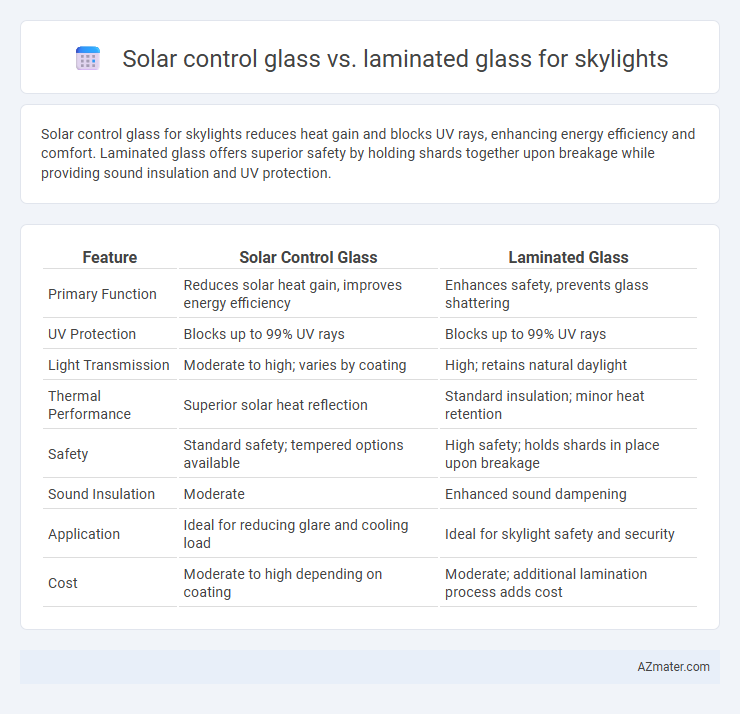Solar control glass for skylights reduces heat gain and blocks UV rays, enhancing energy efficiency and comfort. Laminated glass offers superior safety by holding shards together upon breakage while providing sound insulation and UV protection.
Table of Comparison
| Feature | Solar Control Glass | Laminated Glass |
|---|---|---|
| Primary Function | Reduces solar heat gain, improves energy efficiency | Enhances safety, prevents glass shattering |
| UV Protection | Blocks up to 99% UV rays | Blocks up to 99% UV rays |
| Light Transmission | Moderate to high; varies by coating | High; retains natural daylight |
| Thermal Performance | Superior solar heat reflection | Standard insulation; minor heat retention |
| Safety | Standard safety; tempered options available | High safety; holds shards in place upon breakage |
| Sound Insulation | Moderate | Enhanced sound dampening |
| Application | Ideal for reducing glare and cooling load | Ideal for skylight safety and security |
| Cost | Moderate to high depending on coating | Moderate; additional lamination process adds cost |
Introduction: Understanding Skylight Glass Options
Solar control glass for skylights enhances energy efficiency by reducing solar heat gain and glare, making interiors more comfortable while lowering cooling costs. Laminated glass, designed for safety, combines two or more glass layers with a plastic interlayer to prevent shattering and provide sound insulation. Choosing between solar control and laminated glass depends on priorities such as thermal regulation versus impact resistance and safety for skylight installations.
What is Solar Control Glass?
Solar control glass is designed to reduce heat gain and glare by filtering ultraviolet and infrared rays while allowing natural light to pass through, making it ideal for skylight applications. Laminated glass consists of multiple layers bonded with an interlayer, providing enhanced safety and sound insulation but limited solar heat reduction. Choosing solar control glass for skylights optimizes energy efficiency and indoor comfort by minimizing solar heat penetration without compromising daylighting.
What is Laminated Glass?
Laminated glass consists of two or more glass layers bonded together with an interlayer, typically made of polyvinyl butyral (PVB), providing enhanced safety and impact resistance ideal for skylights. This construction prevents glass from shattering into sharp shards upon impact, reducing the risk of injury and improving durability against weather conditions. Compared to solar control glass, laminated glass offers superior protection and structural integrity but may have slightly lower solar heat reduction capabilities.
Solar Control Glass: Key Features and Benefits
Solar control glass for skylights offers superior heat reduction by blocking up to 70% of solar heat gain, enhancing indoor comfort and reducing air conditioning costs. It features high visible light transmittance combined with low UV ray penetration, effectively protecting interior furnishings from fading. This energy-efficient glass also minimizes glare and improves natural daylighting, making it an optimal choice for sustainable building designs.
Laminated Glass: Advantages and Unique Properties
Laminated glass for skylights offers superior safety and security by holding fragments in place upon impact, reducing the risk of injury. Its unique sound insulation properties enhance indoor comfort by minimizing external noise, while UV filtration protects interiors from harmful radiation and fading. This glass type also provides excellent solar control capabilities, balancing natural light transmission with energy efficiency to maintain comfortable indoor temperatures.
Energy Efficiency Comparison
Solar control glass for skylights significantly reduces solar heat gain by reflecting and absorbing infrared rays, enhancing overall energy efficiency in buildings by lowering cooling costs. Laminated glass provides insulation benefits and UV protection but is less effective in controlling solar heat compared to solar control glass, often resulting in higher energy consumption for temperature regulation. Choosing solar control glass optimizes thermal performance and daylight transmission, making it a superior option for energy-efficient skylight applications.
Safety and Security Considerations
Solar control glass for skylights enhances energy efficiency by reflecting infrared radiation while maintaining visibility, but may offer limited impact resistance compared to laminated glass. Laminated glass consists of two or more glass layers bonded with an interlayer, providing superior safety by preventing shattering and reducing injury risks during breakage. For security considerations, laminated glass delivers enhanced protection against forced entry and accidental impacts, making it a preferred choice in skylight applications requiring both safety and durability.
UV Protection and Fading Prevention
Solar control glass for skylights offers superior UV protection by filtering out up to 99% of harmful ultraviolet rays, effectively reducing interior fading and heat buildup. Laminated glass also provides UV protection through an interlayer that blocks most UV radiation, but its effectiveness depends on the specific interlayer material. When prioritizing fading prevention and long-term UV shielding, solar control glass generally outperforms laminated glass by combining UV filtering with enhanced thermal insulation properties.
Cost Analysis: Solar Control vs Laminated Glass
Solar control glass generally presents a higher upfront cost compared to laminated glass due to its advanced coatings that reduce heat gain and improve energy efficiency in skylights. Laminated glass, while typically less expensive initially, offers enhanced safety and noise reduction but may lead to higher cooling costs without the heat-reflective properties of solar control glass. Over the lifespan of a building, solar control glass often provides better cost savings by reducing the need for air conditioning, offsetting the initial investment compared to laminated glass.
Choosing the Right Glass for Your Skylight
Solar control glass offers superior heat reduction and blocks harmful UV rays, making it ideal for energy-efficient skylights in warm climates. Laminated glass provides enhanced safety and noise reduction with its shatter-resistant interlayer, suitable for skylights in areas prone to impact or extreme weather. Choosing the right glass depends on prioritizing thermal performance versus safety and durability needs for your specific skylight application.

Infographic: Solar control glass vs Laminated glass for Skylight
 azmater.com
azmater.com